 Image search results - "jinja" Image search results - "jinja" |

Yasukuni Shrine is Japan's most prominent shrine for the war dead. Near Kudanshita Station on the Tozai Subway Line. This is the first giant torii
|
|

Yasukuni Shrine during the Mitama Matsuri before dark.
|
|

Kanayama Jinja Shrine is a small shrine within the grounds of the Wakamiya Hachimangu Shrine near Kawasaki Daishi Station. On the first Sun. of April, it holds this now-famous Kanamara Festival nicknamed the Phallus or Fertility Festival. Festival starts at 11 am. But a large crowd was already there well before that time. Entrance to shrine on the day of the Kanamara Festival. (If you're below age 18, please leave now.)
|
|

Path to shrine
|
|
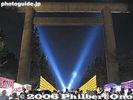
Yasukuni Shrine's main torii during Mitama Matsuri
|
|

Shrine banners and cherries in full bloomThe red banner says "Kanayama Jinja" with an phallus (erect) logo on the top.
|
|
|

Promenade to the shrine
|
|

Pumping (or humping) the...
|
|

Statue of Omura Masujiro (1824-1869) 大村益次郎, founder of Japan's modern army. Also pushed for the establishment of Yasukuni Shrine.
|
|

Spotlights create a silhouette of the statue of Omura Masujiro (1824-1869) 大村益次郎, founder of Japan's modern army.
|
|

The festival is wildly popular with people from overseas.The shrine had various phallus props to pose with.
|
|
|
|

A bon dance around the base of the statue.
|
|

Dickhead hat. Actually, I don't know what they call it, but that's what I call it.
|
|

Second torii
|
|
|
|

Carving daikon. Anybody can join in and carve. 大根削りLater to be auctioned off.
|
|
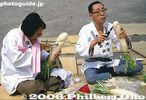
Carving daikon (old photo). These men were really good at carving the daikon.
|
|

You wash your mouth hands here. Built in 1940 by Japanese living in the US. 大手水舎
|
|
|
|
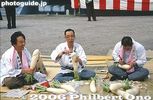
Carving daikon. Since some activities are conducted on the ground, the festival is also called Jibeta (Ground) Matsuri.Once upon a time, the festival was still mostly a local event with much fewer people.
|
|

Gate built in 1934. 神門
|
|

Spotlights hit the torii.
|
|
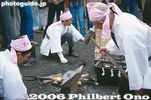
Forging a steel phallus (old photo)The demon living in the vagina of the women bit the man's phallus each time. So one guy made a steel phallus and the demom broke his teeth.
|
|

Back view of second torii
|
|
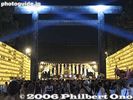
At night, 30,000 lanterns light up. A real summer spectacle.
|
|

Imperial crest on gate door
|
|
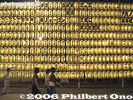
The lanterns are lit by lightbulbs, not candles.
|
|

Standing room only at Wakamiya Shrine
|
|

Way to Tagata Shrine from Tagata Jinja-mae Station. Shrine famous for numerous phallic objects used as offerings to the gods. The 1500-year-old shrine worships a deity called Tamahime-no-Mikoto who was a daughter of a powerful local lord from the 5th c.The Honen-sai or Honen (Hounen) Matsuri is held by Tagata Jinja on March 15 to pray for an abundant harvest. "Honen" literally means "Year of abudant harvest." Since a giant penis is used as an offering, it is popularly called the "penis festival."
The shrine is near Tagata Jinja-mae Station on the Meitetsu Railways' Komaki Line. From Shin-Nagoya Station or Shin-Gifu Station, go to Inuyama Station and transfer to the Komaki Line.
|
|

Tagata Jinja-mae Station on Meitetsu Railways' Komaki Line, a few stops from Inuyama Station. The shrine is a 10 min. walk from the train station.
|
|
|
|
|

Packed path to Wakamiya Hachimangu Shrine
|
|

A group of men carry a red and white pole in front of Inazawa Station, on their way to Konomiya Shrine.
|
|

Festival spectators come by the busload, including people from US military bases such as Yokota.
|
|

Tagata Shrine torii and entrance 田縣神社
|
|

Cherry blossom path to shrine
|
|

Tanabata streamers festoon the gate.
|
|

Prayers to the Kanamara Boat portable shrine かなまら舟神輿 神輿御霊入れ式Before the portable shrine is taken out to be paraded around town, the god of the shrine must be transferred to it. This is what the head priest is doing.
There are three portable shrines (called mikoshi). The Kanamara mikoshi (the original portable shrine), Kanamara-bune mikoshi (shaped like a boat), and Elizabeth mikoshi (pink giant). All three are carried during a procession around town. The Elizabeth mikoshi is carried by she-males. ("New half" in Japanese. Go ahead and laugh if you want.)
|
|

Raising a pole in front of Inazawa Station
|
|

Entering Tagata Shrine, dedicated to Tamahime-no-Mikoto (daughter of a local feudal lord) and Mitoshi-no-Kami (deity of harvests).
|
|

Tagata Shrine stone marker
|
|
|
|
|

Prayers to the Kanamara-bune mikoshi かなまら舟神輿Before the portable shrine is taken out to be paraded around town, the god of the shrine must be transferred to it. This is what the head priest is doing.
|
|

Raising a pole in front of Inazawa Station
|
|

Various entertainment is staged within Tagata Shrine up until the procession starts at 2 pm.
|
|

Mikuji paper fortunes for love and romance, marriage, and childbirth.
|
|

Noh stage and the cherry tree used as the barometer for Tokyo's cherry blossom blooming condition.
|
|

At 6:30 pm, a mikoshi portable shrine was paraded along the promenade.
|
|

The shrine's head priest transfers the deity to the Kanamara Boat portable shrine (boat-shaped loaded with a phallus) かなまら舟神輿Before the portable shrine is taken out to be paraded around town, the god of the shrine must be transferred to it. This is what the head priest is doing.
|
|
|

Schedule of events and procession route. In odd-numbered years (like 2007), the procession starts from nearby Kumano-sha Shrine. In even-numbered years, the procession starts from Shinmei-sha Shrine.
|
|

Tagata Shrine Honden main hall. Komaki, Aichi Pref.
|
|

Yasukuni Shrine, Torii and Haiden hall
|
|
|

A representative of the shrine parishioners offer prayers.
|
|

They zig-zag along the street, and they are filled with sake.
|
|

People line up to rub the sacred balls. Penis rock in the foreground.
|
|

Tagata Shrine Honden main hall which worships shrine worships a deity called Tamahime-no-Mikoto who was a daughter of a powerful local lord from the 5th century.
|
|

Yasukuni Shrine, Haiden hall. After the Class-A war criminals (such as Hideki Tojo) were enshrined here, the late Emperor Hirohito (Showa) never worshipped here again. 拝殿
|
|
|

Prayers to the Elizabeth portable shrine エリザベス神輿Before the portable shrine is taken out to be paraded around town, the god of the shrine must be transferred to it. This is what the head priest is doing.
|
|
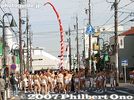
Every once in a while, they raise their pole.
|
|

Sacred Balls. Put in money and rub the left and right ball for family safety, business prosperity, safe childbirth, etc. 珍宝窟
|
|

Torii to Oku-no-miya Shrine, next to the Honden main hall.
|
|

On Aug. 15, the anniversary of Japan's surrender and the end of World War II, Yasukuni Shrine is a busy with worshippers and police. These are police buses.
|
|

Police bus.
|
|

From Kudanshita Station to the first torii, the path is jammed with political activists not even related to the war or shrine.
|
|

Rising Sun flag
|
|

On Aug. 15 at Yasukuni Shrine, you can see former soldiers and nationalists dressed in military uniform marching in the shrine.
|
|
|
|
|

On Aug. 15 at Yasukuni Shrine, you can see former soldiers and nationalists dressed in military uniform marching in the shrine.
|
|
|

On Aug. 15 at Yasukuni Shrine, you can see former soldiers and nationalists dressed in military uniform marching in the shrine.
|
|
|
|
|
|

They march up to the end of the line of worshippers lined up to pray at the shrine. Then they turn around and head back.
|
|
|

Worshippers at Yasukuni Shrine on Aug. 15.
|
|

Worshippers at Yasukuni Shrine on Aug. 15.
|
|
|

Worshippers at Yasukuni Shrine on Aug. 15.
|
|

Praying at Yasukuni Shrine on Aug. 15.
|
|
|

Heavyweight judo Olympic gold medalist Satoshi Ishii (石井 慧) was also at Yasukuni Shrine on Aug. 15, 2009. He was very kind and signed autographs, shook hands, and took photos with a lot of people.
|
|
|
|
|

Waving the sacred sakaki branch to bless all of us
|
|
|
|

Stones and Oku-no-miya Shrine
|
|
|
|
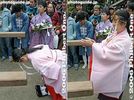
Prayers to the Elizabeth portable shrine エリザベス神輿Before the portable shrine is taken out to be paraded around town, the god of the shrine must be transferred to it. This is what the head priest is doing.
|
|

On the straight road from Inazawa Station to Konomiya Shrine.
|
|

Torii gate to Kumano-sha Shrine.
|
|
|
|

Elizabeth portable shrine エリザベス神輿Before the portable shrine is taken out to be paraded around town, the god of the shrine must be transferred to it. This is what the head priest is doing.
There are three portable shrines (called mikoshi). The Kanamara mikoshi (the original portable shrine), Kanamara-bune mikoshi (shaped like a boat), and Elizabeth mikoshi (pink giant). All three are carried during a procession around town. The Elizabeth mikoshi is carried by she-males. ("New half" in Japanese. Go ahead and laugh if you want.)
|
|
|

Kumano-sha Shrine, the starting point of the procession or "Penis Parade." 熊野社
|
|

This is what you see inside Oku-no-miya Shrine. A giant wooden phallus offering.
|
|

One of the giant spotlights used to accent the mikoshi, torii, and night sky.
|
|

Noh stage
|
|

Nezu Station (Chiyoda Line) platform. Just follow the sign to get out the correct exit. 根津駅
|
|

The Sanno Matsuri Festival is one of Japan's Big Three Festivals and one of Tokyo's Big Three Festivals held in mid-June during several days. The main highlight is the Jinko-sai Procession held every two years. The 600-meter long procession consists of about 500 people parading through central Tokyo near the National Diet, Imperial Palace, Tokyo Station, and Ginza. It includes three portable shrines, carriages, and flower floats. Various events are also held at Hie Shrine which holds the festival. Jinko-sai Procession left Hie Shrine at 8 am on June 11, 2004. Before noon, they approach the Imperial Palace. 山王まつり神幸祭
|
|

Sanno torii gate and the West entrance. Escalator on the right. This torii style is unique to Hie Shrines. The shrine is nearest to Tameike-Sanno Station on the Ginza and Nanboku subway lines. 山王鳥居
|
|

Pubic hair not included. Perhaps that's why it doesn't look so obscene.
|
|
|

Road to Ooagata (Oagata) Shrine, famous for worshipping a rock shaped like the female sexual organ. It also holds the Honen Matsuri for a good harvest and fertility on the Sunday before March 15. 大県神社The shrine is the female counterpart to Tagata Shrine which worships the phallus in neighboring Komaki. The shrine is also noted for weeping plum blossoms.
|
|

Inside Kumano Shrine. Notice the wooden penises on lower left.
|
|

Oku-no-miya Shrine also has many other phallic objects presented as offerings. There even one which you can touch...
|
|
|

Path to Ontake Jinja.
|
|

On the street, just follow the signs to Nezu Shrine. Only a few minutes walk.
|
|
|

The Jinko-sai Procession passes in front of the Imperial Palace.
|
|

Sanno torii gate 山王鳥居
|
|

Elizabeth portable shrine was donated by a drag queen club called Elizabeth Kaikan in Kameido, Tokyo.There are three portable shrines (called mikoshi). The Kanamara mikoshi (the original portable shrine), Kanamara-bune mikoshi (shaped like a boat), and Elizabeth mikoshi (pink giant). All three are carried during a procession around town. The Elizabeth mikoshi is carried by she-males. ("New half" in Japanese. Go ahead and laugh if you want.)
|
|

Konomiya Shrine torii and the long path to the shrine is lined with a large crowd.
|
|

Oagata Shrine torii
|
|

Apparently it can become erect too. (Compare with previous photo.)
|
|

Portable shrine for Takeinadane-no-Mikoto who was a local prince married to Tamahime which Tagata Shrine worships.
|
|
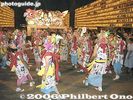
After the mikoshi, the Nebuta float and haneto dancers make an appearance.
|
|

Yushukan war museum 遊就館
|
|

Ontake Jinja 御嶽神社
|
|

Nezu Shrine torii gate 根津神社
|
|

For a procession this large and grand, the crowd of spectators was extremely sparse. Good for photographers like me, but it was strange.
|
|

Sanno torii gate 山王鳥居
|
|

Kanamara Boat portable shrine (boat-shaped loaded with a phallus) was donated by a steel company. かなまら舟神There are three portable shrines (called mikoshi). The Kanamara mikoshi (the original portable shrine), Kanamara-bune mikoshi (shaped like a boat), and Elizabeth mikoshi (pink giant). All three are carried during a procession around town. The Elizabeth mikoshi is carried by she-males. ("New half" in Japanese. Go ahead and laugh if you want.)
|
|

Numerous groups of near-naked men (no women) proceed to the shrine all afternoon.
|
|

Honen Matsuri Festival banner depicting Hime-no-miya
|
|

Phallic objects
|
|

The second portable shrine and main attraction. It is 2.5 meters (13 feet) long, 60 cm diameter, and weighs about 300 kg. It takes 10 days to carve it from a cypress log.
|
|
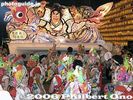
Rassera-rassera!
|
|

Entrance to Yushukan war museum 遊就館
|
|

Nezu Shrine torii gate 根津神社
|
|

Ontake Jinja, main hall on right.
|
|
|
|
|

Two of the portable shrines ready to go. In Japanese, the festival is nicknamed "Chinko Matsuri" (Phallus Festival) ちんこ祭り.There are three portable shrines (called mikoshi). The Kanamara mikoshi (the original portable shrine), Kanamara-bune mikoshi (shaped like a boat), and Elizabeth mikoshi (pink giant). All three are carried during a procession around town. The Elizabeth mikoshi is carried by she-males. ("New half" in Japanese. Go ahead and laugh if you want.)
|
|
|

Honen Matsuri Festival banner disguising the female organ.
|
|

Front view. A new giant, wooden phallus is carved every year since newly-made objects are considered to have more purity and vitality.
|
|

Note that the phallus is not the object of worship. It is an offering to the god.
|
|

Yushukan war museum 遊就館
|
|

Behind Ontake Shrine's main hall is a wall of sculpture.
|
|

The Bunkyo Tsutsuji Matsuri or Azalea Festival is held from April to early May at Nezu Shrine which has a slope filled with 50 varieties of azaleas.
|
|

Hie Shrine's Sanno Matsuri Jinko-sai Procession in front of Imperial Palace.
|
|

Shinmon Gate 神門
|
|

Nebuta float and haneto dancers. Also see the video at YouTube.Mitama Mtasuri at Yasukuni Shrine.
|
|

The main Kanamara mikoshi かなまら神輿There are three portable shrines (called mikoshi). The Kanamara mikoshi (the original portable shrine), Kanamara-bune mikoshi (shaped like a boat), and Elizabeth mikoshi (pink giant). All three are carried during a procession around town. The Elizabeth mikoshi is carried by she-males. ("New half" in Japanese. Go ahead and laugh if you want.)
|
|

Zig-zag to the shrine
|
|

Ooagata Shrine grounds
|
|

It might look light brown here, but it looks more pinkish. It is carved in winter from a hinoki cypress tree by a master artisan wearing ceremonially-purified clothing and using traditional tools.
|
|
|

Inside Yushukan war museum. Impressive, but its version of Japanese war history is skewed. No exhibit on the Pearl Harbor attack either. 遊就館
|
|

Closeup of rear wall sculpture.
|
|

Azalea Garden and Nezu Shrine gate 楼門(国指定重文)
|
|
|

Shinmon Gate 神門
|
|

Awa Odori dancers also performed.
|
|

Kanamara mikoshi かなまら神輿There are three portable shrines (called mikoshi). The Kanamara mikoshi (the original portable shrine), Kanamara-bune mikoshi (shaped like a boat), and Elizabeth mikoshi (pink giant). All three are carried during a procession around town. The Elizabeth mikoshi is carried by she-males. ("New half" in Japanese. Go ahead and laugh if you want.)
|
|
|
|

Votice tablets written with people's wishes for love, sex, and babies.
|
|

Maiden poses with the giant penis. In the past, the phallus was attached to a straw effigy of a warrior, but it was deemed too raunchy and discontinued.
|
|

Inside Yushukan war museum: Photos of the war deceased. Look carefully and you may find photos of Hideki Tojo and co.
|
|

Wedded Pine Trees
|
|

The azaleas usually reach full bloom in late April, but there are flowers which bloom later or earlier so there's always something in bloom during the festival period.
|
|

One of the three portable shrines.
|
|

Shinmon Gate 神門
|
|
|

Ready for the procession
|
|

Another torii
|
|
|

Conch shell
|
|

Place to rub the sacred balls. 珍宝窟
|
|

Yushukan war museum 遊就館
|
|

Another nearby shrine is Tenso Jinja, a 5-min. walk from Ontakesan Station. This is the schedule for their annual Negi-no-Mai Dance held on April 21.
|
|
|

The original procession included many high floats. However, due to overhead power lines and overpasses, such floats cannot be included.
|
|

Sacred Monkey sculpture (Shin'enzo) holding a real banana. The monkey is Hie Shrine's messenger believed to bring marital harmony and children. 神猿像
|
|
|

Taiko drummers in front of Wakamiya Hachimangu
|
|
|
|
|

Banner with ukiyoe shunga-style painting of a penis.
|
|
|
|

Tenso Shrine 天祖神社
|
|

This bridge was recently rebuilt.
|
|
|

Hie Jinja Shrine
|
|

Nebuta close-up
|
|
|

Wakamiya Hachimangu Shrine
|
|

Himenomiya Shrine 姫之宮
|
|

Another mikoshi with a wooden penis. For a good harvest.
|
|
|

Memorial for military dogs which died.
|
|

Tenso Shrine 天祖神社
|
|

The large slope of azalea bushes have walking paths where you can see and photograph the flowers up close.
|
|

Omiko Shrine maidens
|
|

Straw ring and Hie Jinja Shrine's Shaden Worship Hall. 社殿
|
|

Nice to see a bit of Aomori in Tokyo.
|
|

Romon Gate 楼門
|
|

Kanayama Shrine (right next to Wakamiya Hachimangu)Kanayama Shrine is dedicated to a pair of gods named Kanayama Hikonokami and Kanayama Himenokami 金山比古神(かなやまひこのかみ) 金山比売神(かなやまひめのかみ. According to legend, when the main Shinto god named Izanami gave birth to the God of Fire, her lower abdomen got burned. These two Kanayama gods helped to heal her birth wound. Thus, these two gods came to be known as the gods of childbirth and healing of the lower abdomen. They later came to be worshipped as fertility gods, protector of sexually-transmitted diseases (AIDS, etc.), and successful marriage. They are also the gods of the bellows, so blacksmiths (who use bellows to fan the fire) also worship this shrine.
Kanayama Shrine is a small shrine within the grounds of the larger Wakamiya Hachimangu Shrine. The Kanayama Shrine was completely rebuilt and reborn in 1999 into a completely unorthodox building which you see here. Modeled after a blacksmith's workshop, it is now a black, eight-sided building with steel paneling. Notice the penis monument on the lower right.
|
|

Himenomiya Shrine 姫之宮
|
|

Nose jobI didn't see this among the souvenirs being sold. Wonder where he got it.
|
|

Rub the two balls.
|
|
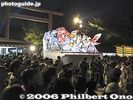
After the Nebuta made its way in front of the shrine, a short prayer was held.
|
|

Memorial for military horses which died.
|
|

Tenso Shrine altar
|
|

Nezu Shrine, Tokyo
|
|

Flower float, Sanno Matsuri
|
|
|

After passing through this gate, the men enter the shrine grounds. Romon Gate 楼門
|
|

Penis prayersThis penis monument (built in 1995 by a steel company) is next to Kanayama Shrine. This person praying is a Caucasian man, not a woman. I was aghast when he stood up and showed his manly face. His long blond hair made me think he was a woman...
|
|

Hime-no-miya Shrine 姫之宮
|
|

Procession maidens pose with wooden penises. Tagata Shrine Honen Festival
|
|

Put in money and it will make a "chin" sound. (From the word "chinpo" for penis.)
|
|
|
|

Yushukan war museum 遊就館
|
|

Negi-no-Mai Sacred Dance at Tenso Shrine on April 21, starting at 3 pm. 禰宜の舞
|
|

Some bushes are in full bloom, while others are still too early.
|
|
|
|

Inside Hie Jinja Shrine's Shaden Worship Hall. 社殿
|
|

Haiden Hall where the men offer their long poles. 拝殿
|
|

Licking it...Look at that tongue...
|
|

On the right of Himenomiya Shrine, is a narrow, non-descript path going to the rear.
|
|

Procession maidens pose with wooden penises.
|
|

Phallic fence posts.
|
|

Mother Statue 母の像
|
|

The dance is a prayer for a good harvest and to ward off bad luck. This dance was once performed by about 20 shrines along the Tamagawa River in Tokyo and Kawasaki. Now, only this shrine performs it in Tokyo. 天児屋根命(あめのこやねのみ�This god is called Amenokoyane-no-Mikoto (god of festivals).
天狗様「猿田彦命(さるたひこのみこと)」や、神事、祭りを司る神「天児屋根命(あめのこやねのみこと)」、山の幸の神「彦火火出見命(ひこほほでみのみこと)」など、それぞれの役どころを表現する個性豊かな神の舞を見せてくれる。
|
|
|
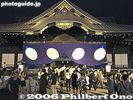
The shrine
|
|
|
|
|

Haiden Hall 拝殿
|
|

Riding it...Obviously I have better shots of her with her cute face showing and both arms in the air, but I'm not one to embarass people...
It has been scientifically proven that sex is good for your health and beauty.
|
|

There it is. The female rock. 女性器をかたどった石
|
|
|
|
|

Memorial for sunken naval warships
|
|

A small square area with a straw mat enclosed by a shimenawa sacred rope is the makeshift stage for the Negi-no-Mai Sacred Dance at Tenso Shrine.
|
|
| 2648 files on 11 page(s) |
1 |
 |
 |
 |
 |
|